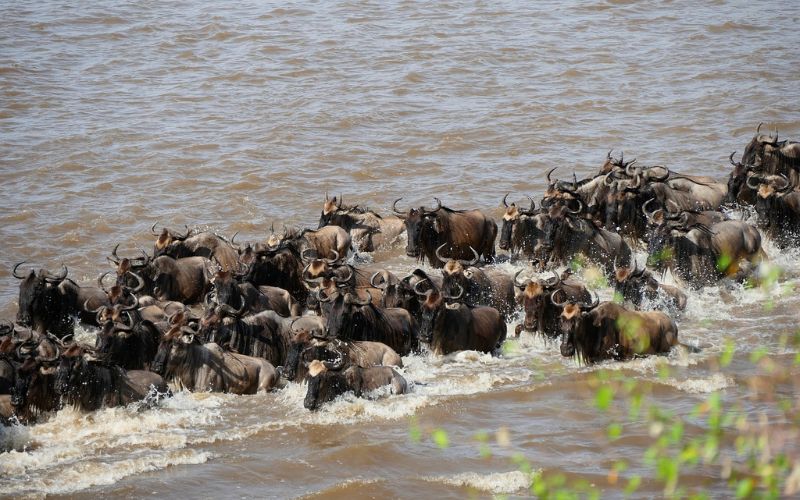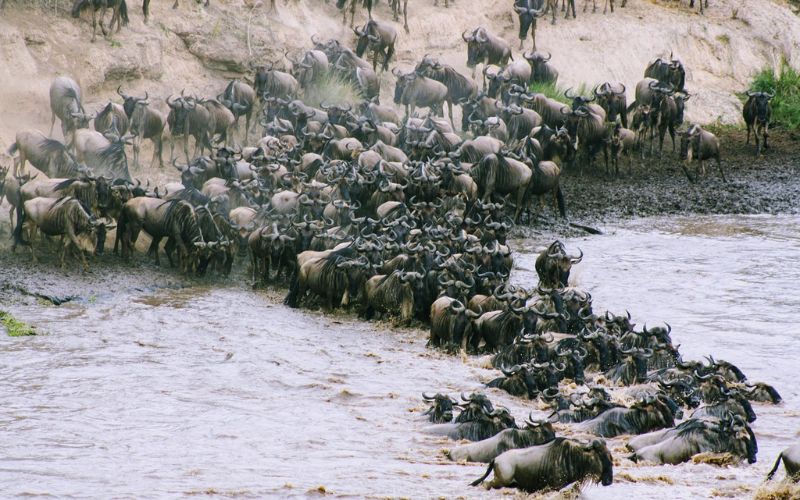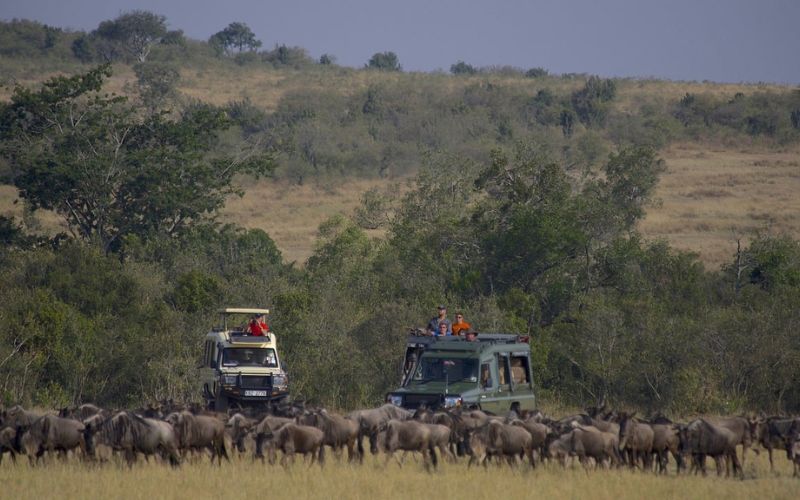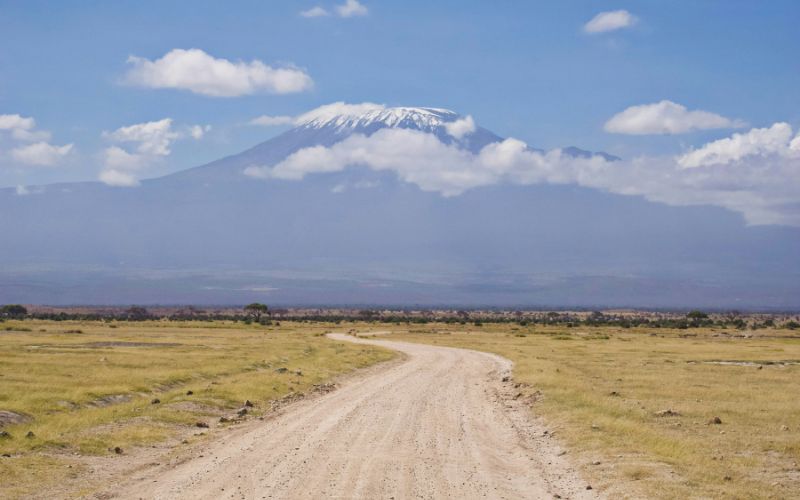

The Great Wildebeest Migration: A Month-by-Month Guide
The Great Wildebeest Migration is one of nature’s most awe-inspiring spectacles, involving the movement of over two million wildebeest, accompanied by zebras and gazelles, across the vast savannas of the Serengeti in Tanzania and the Masai Mara in Kenya. This incredible journey is driven by the search for greener pastures and water, following the seasonal rains. Here is a month-by-month guide to help you understand the migration’s rhythm and plan your visit to witness this natural wonder.
I really had a very nice experience on my Masai Mara Safari with Africa Vacation Safaris.
We saw lions and cheetahs my favorite animals. I was so impressed on this safari. Accommodation chosen by Denis was so unique with best staff ever.
Our guide too was so knowledgeable and patient with us.
– Faisal Nawab, Russia – via TripAdvisor
January: Calving Season in the Southern Serengeti
The year begins with new life in the southern Serengeti plains and the Ngorongoro Conservation Area. January is calving season, with over 500,000 wildebeest calves born within a span of a few weeks. This abundance of newborns attracts predators such as lions, cheetahs, and hyenas, making it a dramatic period for wildlife enthusiasts. The short grass plains offer excellent visibility, making January an ideal time for photographers and wildlife watchers.
February: The Plains are Alive
February sees the continuation of the calving season. The southern Serengeti remains lush and teeming with life as the herds stay to nourish their young. This month offers a high chance of witnessing predator-prey interactions. The spectacle of thousands of calves running alongside their mothers is a unique experience. The weather remains warm, with occasional rains keeping the plains vibrant.
March: Preparing for the Journey
As March progresses, the herds begin to gather in preparation for their journey northward. The grass in the southern plains starts to deplete, signaling the need to move. While the migration is not yet in full swing, smaller movements towards the central Serengeti can be observed. Predators continue to thrive, taking advantage of the dwindling abundance of calves.
April: Moving Towards Central Serengeti
By April, the rains encourage the wildebeest to begin their migration in earnest. The herds start moving northward towards the central Serengeti. The landscape becomes lush with new grass, and the plains are filled with the cacophony of bleating wildebeest. This transitional period provides a quieter experience for travelers compared to the peak migration months, but the wildlife viewing is still spectacular.
May: Long Columns on the Move
May marks the formation of the iconic wildebeest columns stretching across the Serengeti. The herds move steadily northward, creating an unforgettable spectacle as they traverse the verdant plains. This is also the mating season, adding an extra layer of activity to the migration. Travelers can witness the synchronization of the herds as they follow ancient paths.
June: Crossing the Grumeti River
In June, the herds reach the western Serengeti and face their first significant obstacle: the Grumeti River. Though less dramatic than the Mara River crossings, the Grumeti River crossings are still fascinating, as crocodiles lie in wait for the unsuspecting wildebeest. The landscape of the western corridor provides a picturesque backdrop, with woodlands and rolling hills enhancing the experience.
July: Arriving at the Mara River
July is one of the most anticipated months of the migration as the herds reach the northern Serengeti and the Masai Mara. The Mara River crossings are world-renowned for their drama and intensity. Thousands of wildebeest plunge into the river, braving strong currents and crocodiles in their desperate bid to reach the lush grasses of the Masai Mara. The crossings are unpredictable, requiring patience and luck to witness.
August: Abundance in the Masai Mara
In August, the herds spread out across the Masai Mara, enjoying the rich grazing opportunities. This is a time of relative calm after the perilous river crossings. Predators, including the famous lion prides of the Masai Mara, take full advantage of the abundance of prey. The golden grasslands of the Mara provide stunning photographic opportunities, especially during sunrise and sunset.
September: The Masai Mara Spectacle
September continues the spectacle in the Masai Mara, with the herds still present in large numbers. This is an excellent time to witness predator-prey dynamics, as lions, cheetahs, and leopards remain active. The weather is generally dry, making it an ideal time for game drives. The rolling landscapes and open plains offer unparalleled views of the wildlife.
October: Preparing for the Journey South
As October progresses, the herds begin to gather for their journey back to the Serengeti. The rains start to return to the southern Serengeti, signaling the end of the dry season. Smaller crossings of the Mara River occur as the wildebeest head south. This transitional period offers quieter safari experiences, with fewer tourists and still plenty of wildlife action.
November: Returning to the Serengeti
November sees the herds moving back into the Serengeti as the short rains bring fresh grass to the southern plains. The journey south is more spread out, with smaller groups gradually merging. This period offers a sense of the migration’s cyclical nature and provides excellent opportunities for photography without the crowds.
December: Settling in the Southern Plains
By December, the herds have returned to the southern Serengeti and Ngorongoro Conservation Area. The plains become vibrant once again, setting the stage for the next calving season. The herds spread out across the grasslands, and the cycle begins anew. December’s lush landscapes and abundant wildlife make it a great time for travelers seeking a more serene experience.
Tips for Witnessing the Migration
- Timing is Key: The migration’s movements depend on rainfall, so flexibility in travel plans is essential. Consult local experts or tour operators for the latest updates.
- Choose the Right Location: From the calving grounds of the southern Serengeti to the dramatic river crossings of the Mara, each stage of the migration offers unique experiences.
- Plan Ahead: Popular months like July and August require early booking for accommodations and permits, especially in the Masai Mara.
- Travel with Experts: Experienced guides can maximize your chances of witnessing key moments of the migration.
- Pack Smart: Bring appropriate clothing for varying weather conditions and quality camera equipment to capture the action.
Conclusion
The Great Wildebeest Migration is a testament to the resilience and instinctual drive of nature’s creatures. Whether you’re drawn to the tender moments of the calving season, the heart-pounding drama of river crossings, or the serene beauty of the Masai Mara, each phase of the migration offers something extraordinary. By understanding the migration’s timeline, you can plan a journey that aligns with your interests and ensures an unforgettable safari adventure.




About The Author
Africa Vacation